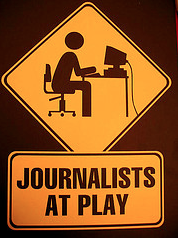By Andrew Gibson
This is the third post in a series about what I think are the five most difficult parts of journalism. My opinions are based on one year at Mizzou in Columbia, Mo., and an internship this summer at KCNC-TV in Denver.
There’s a great irony in reporting.
Journalists are expected to dig into the depths of a story, examining every relevant angle, yet condense what they find into something readers can skim in minutes.
That’s challenge No. 3: judging what information is important. And doing so quickly.
I learned to use this reporting skill in News (Journalism 2100), and one experience called “man on the street” sticks out in my mind. Everyone in my class had to draw a story idea from a hat, gather background information, interview two people and write a 250- to 350-word story, all in 90 minutes.
My topic was the federal budget. Luckily, I follow political news closely, so I generally knew what was happening on Capitol Hill at the time. But the topic was still overwhelmingly broad.
So I sat down at my computer and asked myself, “What does the audience need to know about the budget? What news angle would make people want to read this?“
With that in mind, I read a few articles for background, scribbled some notes and made a preliminary outline. I then rushed outside, interrupted two people’s lunches, hurried back and started typing. All the while, I kept my audience in mind.
The finished product may not have been the most polished piece of journalism, but it was easy to read and approachable. I think the average person could have learned something about the federal budget and how Columbians felt about it at the time by reading my story.
Accomplishing that goal was one of the landmark moments of my first year at the Missouri School of Journalism.
But I only did one “man on the street.” Making on-the-fly news judgments will soon be a part of my career everyday, and I’ll face tougher decisions than what to include in an unpublished federal-budget story.
I practiced information selection this summer as an intern at KCNC-TV in Denver. Writing readers, voiceovers and packages is an excellent drill in conciseness because reporters only get 20, 30 or 75 seconds to tell a story.
Broadcast is funny like that. Reporters will spend their entire day working on a 60-second package.
I have room for improvement, no doubt. I almost always used every second of air time even when, as my internship coordinator pointed out, I could say the same thing in half the time. Sometimes I wrote too formally, failing to speak in the “language of the people.”
But I’m not discouraged. I walked into the KCNC-TV newsroom with no broadcast experience to my name. I got the chance three days a week to improve my conciseness and information selection.
It’s a difficult skill, but one that I’m starting to grasp.
Writing for The Maneater, the MU student newspaper, next semester will give me even more practice. Many of the story pitches are complex and contain “guide” questions that could make for in-depth stories by themselves. But the majority of the word limits are 400 to 500 words. That means I’ll have to choose information the audience will find both interesting and informative. And I won’t be able to sit and puzzle over it for long because I’ll be on a deadline.
That’s No. 3 on the countdown. However, journalists aren’t just expected to be good selective writers. They’re also expected to fully understand the topic for which they’re picking information.
Which leads me to the No. 2 challenge on the countdown: the requirement that journalists know something about everything.
Did you miss No. 4 and No. 5? Click the links!
Cross posted from Andrew Gibson’s personal blog.
Photo at top taken from Lisa Padilla’s Flickr account.


No comments:
Post a Comment